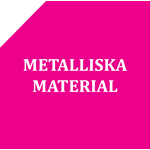Projektinitiativ #25: Tailored mechanical performance for AM components ( 3 kommentar)
Metal additive manufacturing (AM) is an attractive method to fabricate complex shaped structural components. The aim of this proposal is to provide a tool for design engineers to tailor mechanical performance of AM components to meet the specified industrial needs especially at elevated temperatures.
Alexander Angré presents the initiative during the 2017 conference
The mechanical properties of metallic components are largely governed by the microstructure characteristics. However in AM, the relationships between the mechanical properties, the microstructure and the manufacturing process (including post processes such as heat treatments) are not sufficiently characterized and therefore not well understood. This lack of maturity in terms of material knowledge and procedures for design of components with desired properties is a hinder for the efficient implementation of AM in industrial production. The focus of this project is on establishing comprehensive understanding on the relationship between the microstructure and mechanical performance of materials used in elevated temperature environments.
 Fig. Microstructure in a form of an inverse pole figure map showing Inconel 718 specimen built by Electron Beam Melting (EBM). The mechanical properties of the specimen have not yet been tested. (Which loading direction has the highest yield strength??)
Fig. Microstructure in a form of an inverse pole figure map showing Inconel 718 specimen built by Electron Beam Melting (EBM). The mechanical properties of the specimen have not yet been tested. (Which loading direction has the highest yield strength??)
Namn Irma Heikkilä
Organisation Swerea KIMAB AB
Kommentar #1
I agree with your indication about lack of characterization data of AM structures. There is also a lack of in-situ process data as most AM systems are quite closed. It might be of interest to know that NIST in US is advancing some test-suites (AM-Bench) lead by Dr L Levine that will improve the state considerably. The division of Material Mechanics at Luleå University of Technology has had and still has projects where we simulate AM of Inconel 718 (and also other materials). We compute both thermal and mechanical fields as well as microstructure evolution, particularly gamma''-precipitates. The microstructure information is coupled to the plasticity modeling and thus we can also simulate the ageing process of the material where is initially is in the soft annealed state ending up in a creep-resistant aged state. The finite elements simulations are used for design of the process and component geometry. Characterization of the process will improve as well as validate modeling and thus this proposal is of interest for us. The need for experiments is also why I am engaged and part of the steering group for AM-bench.
Namn Lars-Erik Lindgren
Organisation Luleå tekniska universitet
Kommentar #2
A very relevant and important field of research. There is a growing need to develop novel materials for applications where high temperature mechanical and tribological properties are cruical for efficient operation of various technological systems. The possibilties offered through AM with tailored microstrucutres and functionalties not availble in other bulk materials makes it a key technology for enabling future high performance materials. There is a lack of understanding when it comes to the correlation bewteen process parameters - resulting microstructure - tribological performance. The characterisation of friction and wear performance of novel AM materials in extreme operating conditions is in line with the high temperature tribology research at the Division of Machine Elements at Luleå University of Technology.
Namn Jens Hardell
Organisation Luleå tekniska universitet
Kommentar #3
Intressant för Quintus.
Namn Stefan Sehlstedt
Organisation Quintus Technologies AB

